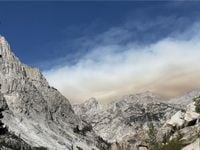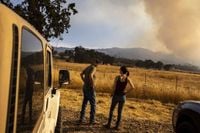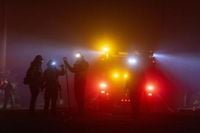Wildfires have long been a part of the American landscape, especially in the West. But in recent decades, their frequency and intensity have surged across the United States, a trend that scientists tie directly to the mounting effects of climate change. While the charred remains of forests and destroyed homes are the most visible aftermath, the silent, drifting threat of wildfire smoke is emerging as a far more insidious and widespread danger to public health.
Groundbreaking research published on September 18, 2025, in Nature has brought this hidden crisis into sharp focus. Led by Minghao Qiu, PhD, of Stony Brook University, and with contributions from Stanford University and other institutions, the study provides the most comprehensive assessment to date of the mortality burden linked to wildfire smoke—specifically, the fine particulate matter known as PM2.5—under future climate change scenarios.
Wildfire smoke is a complex cocktail of chemicals, but it’s the PM2.5 particles—tiny enough to penetrate deep into the lungs and even enter the bloodstream—that present the greatest risk. According to the Nature study, exposure to these particles exacerbates respiratory and cardiovascular conditions and is associated with a significant increase in premature deaths. The researchers found that deaths from wildfire smoke can occur not just in the days or weeks following exposure, but can persist for up to three years after the initial event. This prolonged impact means that the health consequences of a single smoke event can ripple through communities long after the skies have cleared.
“The link between wildfire exposure and mortality burden can be very high, and what we are seeing is a clear increase in wildfire smoke nationwide, including long-range transport of smoke and dangerous particulates across the nation,” said Qiu, the study’s lead author and an assistant professor at Stony Brook University, as reported by Stony Brook News.
To arrive at their projections, the research team employed an innovative ensemble of statistical and machine learning models. By integrating historical climate data, wildfire activity, and atmospheric transport models, and calibrating them with observational PM2.5 data and U.S. mortality statistics, they were able to bridge the gap between environmental changes and health outcomes. This interdisciplinary approach allowed for more accurate forecasts of future mortality attributable to wildfire smoke as the climate continues to warm.
The numbers are sobering. Under a high-emissions climate pathway (SSP3-7.0)—essentially a “business-as-usual” scenario—the study projects that wildfire smoke PM2.5 could cause approximately 71,420 excess deaths per year in the United States by 2050. That’s a dramatic 73% increase over the 2011–2020 baseline average of annual excess deaths linked to smoke. The cumulative effect is even more staggering: from 2026 to 2055, the U.S. could see as many as 1.9 million excess deaths due to wildfire smoke PM2.5 alone, according to Nature.
While the West has historically borne the brunt of wildfire activity, the study found that as climate and vegetation patterns shift, smoke burdens are likely to spread further eastward. “What we see, and this is consistent with what others find, is a nationwide increase in wildfire smoke,” Qiu told Science X. “There are larger increases on the West Coast, but there’s also long-range transport of wildfire smoke across the country, including massive recent smoke events in the Eastern and Midwestern U.S. from Canadian fires.”
Marshall Burke, senior study author and professor at the Stanford Doerr School of Sustainability, emphasized the broadening scope of vulnerability. “Our understanding of who is vulnerable to this exposure is much broader than we thought,” Burke explained to Stony Brook News. “It’s pregnant people, it’s kids in schools, it’s anyone with asthma, it’s people with cancer. We look at one specific health outcome in this study—mortality—and, unfortunately, find a shared burden of exposure for individuals across the U.S.”
Beyond the tragic human toll, the economic implications are equally alarming. The study estimates that, when monetized, deaths related to wildfire smoke could reach $608 billion in annual damages by 2050 under a scenario where global temperatures rise about 2 degrees Celsius above pre-industrial levels. That figure surpasses current estimates of economic costs from all other climate-driven damages in the U.S. combined, including temperature-related deaths, agricultural losses, and storm damage, as reported by Science X.
“When monetized, climate-induced smoke deaths result in annual damages that exceed prior aggregate estimates of all other economic damage due to climate change in the U.S. – meaning wildfire smoke could be the most deadly and damaging climate disaster in the U.S.,” Qiu noted in the Stony Brook University press release. This redefines the scope of economic risk tied to climate change, positioning wildfire smoke as a leading contributor to climate-related financial burdens on society.
The study’s methodology stands out for its rigor and innovation. By linking county-level U.S. death records from 2006 to 2019 with ground-level smoke emissions, wind variation, and the movement of airborne particulate matter, the researchers were able to predict how wildfire emissions in one area affected smoke concentrations in another. Global climate models were then used to project future fire activity, smoke levels, and health impacts under different warming scenarios through 2050.
Importantly, the authors stress that their estimates focus solely on mortality, and do not include the short- and long-term non-fatal health impacts of smoke PM2.5—such as increased morbidity, worsened mental health, or potential long-term cancer risks. The true burden of wildfire smoke on public health is therefore likely even greater than the numbers suggest.
So, what can be done? The study’s authors advocate for urgent adaptation and mitigation strategies to reduce the health impacts of wildfire smoke. These include better land management—such as prescribed fires to reduce the risk of uncontrolled wildfires—enhanced air quality monitoring, community-level interventions like indoor air filtration programs, and targeted protections for vulnerable populations. At the same time, aggressive action to curb greenhouse gas emissions remains critical to slowing the trajectory of warming and wildfire intensification.
“If you look at the leading climate impact assessment tools that are used to inform policy, none of them incorporate how changes in climate could influence wildfire smoke and related human mortality,” Qiu told Science X. “Our study shows climate models are missing a huge part of the climate impacts in the U.S.—it’s like leaving the main character out of a movie.”
The implications of this research extend beyond America’s borders, serving as a cautionary tale for other regions facing rising wildfire risks under climate change. The intersection of environmental change, wildfire dynamics, and human health is now a critical frontier for both scientific inquiry and policy innovation. As the evidence mounts, the need for interdisciplinary collaboration and decisive action has never been clearer.
In the end, the study’s message is stark: wildfire smoke exposure is not merely a regional nuisance, but a looming public health and economic crisis driven by global climate forces. The time to act—through both adaptation and emissions reductions—is now, before the toll grows even higher.



